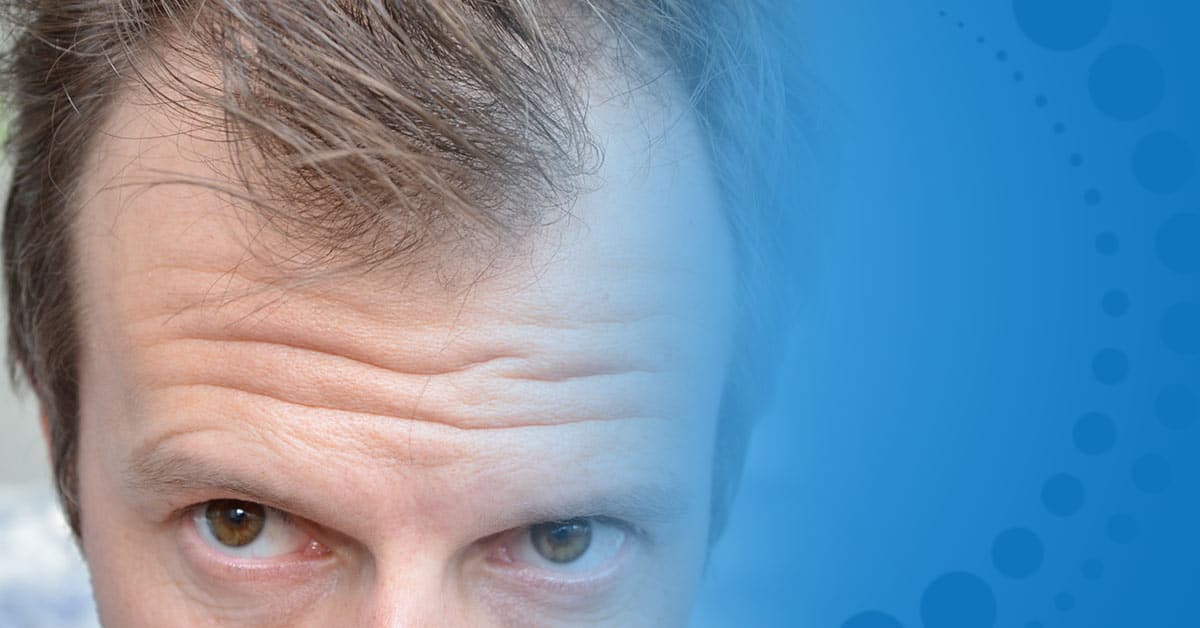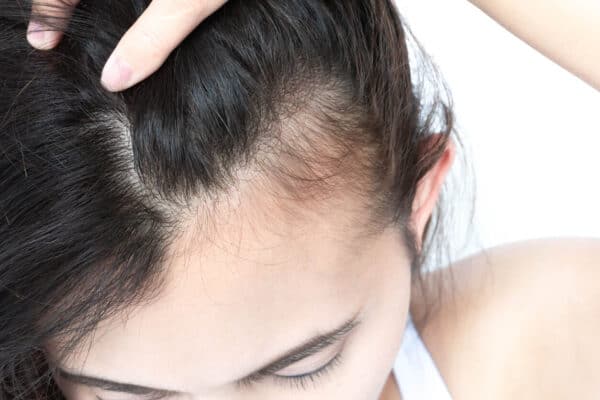What Is Telogen Effluvium?

The hair follicles on your scalp cycle through stages of resting and growth. Typically the hair growth cycle is characterized by growing for two or more years, resting for a few months, and then beginning again.
At any given time, 80-90% of hair follicles on a healthy scalp are in this growing phase called the anagen phase. The rest are in the resting phase – or the telogen phase.
In a person suffering from telogen effluvium, the anagen phase has slowed, and 30% (or more) of a person’s scalp hair is in the telogen phase. Therefore, telogen effluvium symptoms are expressed as excessive shedding and hair thinning.
Common Questions About Chronic Telogen Effluvium (Hair Shedding)
Many people become anxious when they notice increased scalp hair shedding. Unfortunately, hair health is often stress related, so being stressed when you see hair fall on the floor may lead to even more hair loss.
There are two things you need to remember if you are experiencing telogen hair. The first is that you are not alone. This condition is shared by both men and women – of all ages. The second thing you need to remember is that professional help is possible.
Here are some answers to questions about the telogen effluvium hair cycle.
How common is telogen effluvium?
We know that the name alone may give you cause for concern. However, telogen effluvium is considered the second most common form of hair loss diagnosed by dermatologists, with androgenetic alopecia (male pattern hair loss or female pattern hair loss) being the most common.
What do telogen hairs look like?
Hairs in the telogen phase often have a white bulb at the end nearest to the scalp. In addition, telogen hairs will not have a gel-like covering around that end of the hair.
These characteristics show that the hair follicle has been cut off from its blood supply and has stopped growing. Telogen hair is sometimes called club hair.
You can contrast this with anagen hair. Anagen hair is tapered, narrowed, irregular, or broken off at the end of the hair nearest the scalp. In addition, Anagen hairs are pigmented with long roots covered with inner and outer root sheaths.
Still not sure you have a hair loss problem?
It’s worth noting that losing fewer than 100 hairs in a day is considered normal. So even if your hair loss seems excessive, it might align with the norm. A professional will be able to diagnose the problem by looking at the hairs that are falling out of the scalp.
What are the causes of telogen effluvium?
Extreme physical or emotional stress are key triggers of telogen effluvium. Unfortunately, you may not notice thinning hair until one or two months after the trigger event.
Here are some additional causes of this unwanted hair cycle:
- Illness or fever
- Major surgery
- Severe infections
- Extreme emotional trauma, such as the loss of a loved one or job loss
- Starting, stopping, or changing hormone medications
- Sudden rapid weight loss
- Entering menopause
- Abnormal thyroid hormone functions or a change in thyroid medication
- Pregnancy, delivery, or miscarriage
- Poor diet (Deficiencies in iron, zinc, vitamin B-6, and vitamin B-12 might cause TE.)
Other causes of hair loss
As you can see, finding a cause for hair shedding may be tricky. It can be the result of physical trauma, such as caused by a car crash or having surgery, or it can be caused by exposure to toxins.
Some antidepressants, beta-blockers, nonsteroidal anti-inflammatory drugs, and other medications may also cause hair loss.
If you think your hair shedding might result from a recently prescribed medication, talk with your doctor to see if they can recommend a different drug.
To make things more complicated, it’s important to note that hair shedding can be a symptom of another condition, such as alopecia areata incognita – or it could be caused by something as simple as an allergic contact dermatitis to hair dyes or another similar product.
As soon as you notice significant hair loss, schedule an appointment with a professional. They may help you determine the cause – and, most importantly – help you find a solution.
Is there always a clear cause of telogen effluvium?
No, sometimes there’s no clear cause of chronic telogen effluvium. This is especially true for female patients 30 to 60 years old.
How do I know if I have telogen effluvium?
You might notice yourself shedding more hair than usual. It’s also worth noting that you probably don’t have telogen effluvium if you have large bald patches. But, of course, this can be confused with other causes of hair loss, so it is best to consult a doctor to receive a professional diagnosis.
What tests will be done to diagnose telogen effluvium?
First, the doctor may look for signs of androgenetic alopecia, sometimes characterized by a receding hairline.
Telogen effluvium, on the other hand, is usually characterized by excess shedding and overall hair thinning.
Then, the healthcare provider may complete a physical examination of your scalp. They may conduct a “pull test.” If the patient has telogen effluvium, the doctor may pull at least four to six hairs from the scalp with white bulbs at the roots instead of one or two healthy hair follicles.
Your healthcare provider will also ask about your diet and medical history. They may identify a dietary cause – or stress or illness – that occurred about three months before you noticed hair loss.
In many cases, someone with telogen effluvium has fully recovered from a stressor or illness and doesn’t see a connection between it and their hair loss.
In most cases, your healthcare provider can diagnose telogen effluvium without blood work. However, they may recommend further testing, including blood tests or a scalp biopsy, if they suspect a condition or illness has caused telogen effluvium.
Follow-up tests
The doctor may ask you to gather all hairs that fall out of your head over 24 hours. You also may be asked to collect and count lost hairs every one or two weeks to see when the shedding starts to decline.
How long does TE last?
Fortunately, most cases of telogen effluvium are short-lived. Acute telogen effluvium generally begins three months after a triggering event. Your hair will return to its usual growth cycle within six months – though it may take a year to eighteen months before it returns to its pre-TE appearance.
What is the difference between acute telogen effluvium and chronic telogen effluvium?
Chronic telogen effluvium is a more persistent condition and can fluctuate for years.
The key to chronic or acute telogen effluvium treatment (if possible) is to remove the sources of stress that caused the incident in the first place. Of course, if it continues, you should contact a hair loss expert.
Can you go bald from telogen effluvium?
Telogen effluvium doesn’t typically lead to complete baldness, though your hair may appear thin. Though in the early stages, shedding can seem severe, and hair may come out in handfuls.
Severe cases of telogen effluvium may also affect your eyebrows and body hair.
Is there a treatment for telogen effluvium?
Telogen effluvium should resolve on its own. However, your doctor may recommend the following options:
- Medications: There are over-the-counter scalp medications that promote hair regrowth. However, these medications have some side effects, and some may not be used if you are pregnant or breastfeeding.
- Multivitamins or supplements: Your doctor may recommend multivitamins that contain iron and/or biotin supplements.
- Medicated shampoos: Medicated shampoos may be able to diffuse hair loss. Talk with your doctor about this treatment option.
We know that hair loss can be devastating. Talk with a hair loss expert near you to learn about additional options.
Is female pattern hair loss related to telogen effluvium?
No, female pattern hair loss is known as androgenetic alopecia. It typically occurs at an early age or following hormonal changes. Female androgenetic alopecia usually affects the front and sides of the scalp.
Hair density and thickness generally are preserved in the frontal hairline and occipital scalp – or the lateral area that extends from ear to ear in the rear of the head.
A woman with androgenetic alopecia may notice her part becoming wider over time.
When telogen effluvium most commonly occurs in women
On the other hand, women are typically diagnosed with telogen effluvium when they are in their 40s, 50s, or 60s. They may notice significant hair shedding over the entire scalp or thinning that happens abruptly.
If you are concerned about female pattern hair loss or telogen effluvium, consult a doctor or hair loss expert. As we previously noted, an expert conducting a scalp exam and hair pull test may be able to diagnose the cause of the problem quickly.
What can I promote hair growth (and minimize hair loss)?
Living a healthy lifestyle and finding ways to cope with stress may help you minimize hair loss and hair shedding. Also, hair loss experts recommend the gentle handling of the hair. (Avoid vigorous brushing or scalp massages.)
- Eat 40 to 60 grams of protein daily and eat fruits and vegetables that may help minimize hair loss, such as berries, spinach, and avocados.
- Take vitamins.
- Find ways to eliminate or cope with stress.
- Get enough quality sleep.
However, even those with the healthiest diet and best intentions still suffer from hair loss. You don’t have to live with thinning hair. Learn about treatment options by visiting a local hair restoration clinic.
COVID and Hair Loss
According to a September 2022 article in the New York Times, 22 percent of those who were hospitalized with Covid-19 experienced temporary hair loss or acute telogen effluvium. Those troubled by hair loss are inundating area dermatologists and hair loss specialists.
While problems with hair growth are common for those who have experienced illness, surgery, childbirth, and extreme emotional events, it has been found that people with a history of Covid-19 infection were four times as likely to develop hair loss than those who never were infected with Covid.
The exact reason for the increased likelihood of hair loss following Covid isn’t clear, although doctors guess it might be caused by the physical and mental stress of the disease.
Talk to Austin Hair Restoration About Your Hair Loss
If you’ve been noticing thinning hair and aren’t sure of the reason, Austin Hair Restoration Clinic offers a free consultation to determine the cause of your hair loss. Our experts will determine whether you are a good candidate for a hair restoration procedure.
We use the minimally invasive ARTAS Robotic Hair Transplant System, which produces exceptional results and will get you back to your day-to-day life in just a few days.
Dr. Sanjeev Dubey is an experienced hair restoration and emergency medicine physician in Austin, Texas. He holds a medical degree from the University of Texas Medical Branch (UTMB) and has been practicing medicine for over two decades. His affiliations include Seton Medical Center Austin, Seton Northwest, and various local hospitals.








